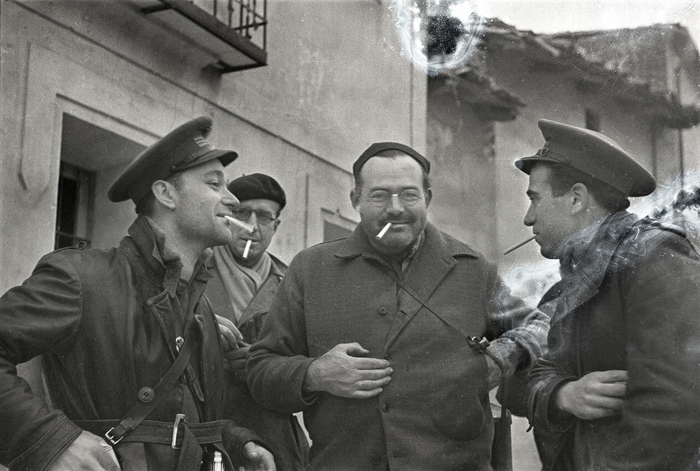
The international news in 1937 was dominated by the civil war in Spain, with nearly daily reports of fierce battles, atrocities and political intrigue. Many Americans fought Franco’s forces in the war in the International Brigades but by the end of the year, it was becoming clear that Franco had the upper hand. Ernest Hemingway covered the war as a correspondent and his experiences provided the material for what many believe to be his best novel: For Whom the Bell Tolls. On a less pleasant note, thousands of formerly powerful people were being executed in Stalin’s purge of Russia’s elite; Japan invaded China and Hitler, in a speech to the German parliament, made clear he intended to eliminate the Jews from Europe.
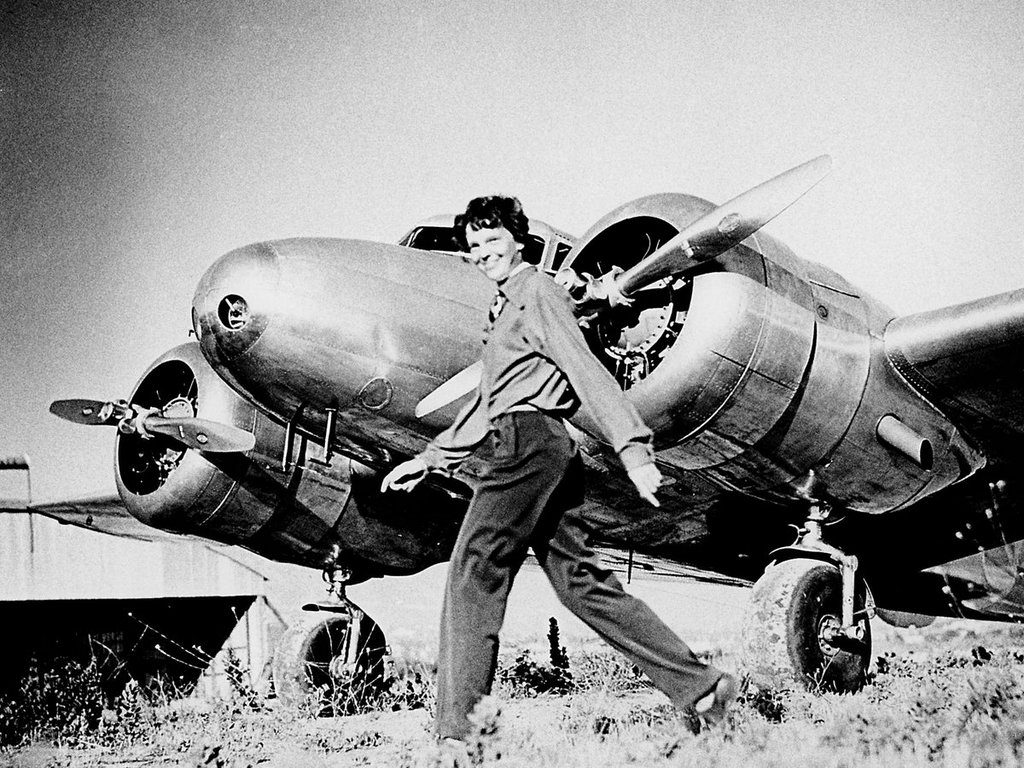
In this country FDR tried unsuccessfully to pack the Supreme Court and Amelia Earhart disappeared in the Pacific. In entertainment, Charlie Chaplin’s first talkie “Modern Times” was released; Daffy Duck made his debut; and Walt Disney produced its first full length animated picture “Snow White.” The first Social Security check was issued and the Calais Advertiser carried weekly columns explaining the new benefit to the public; steelworkers were being paid $5 a day; and Margaret Mitchell won the Pulitzer Prize for Gone with the Wind. In baseball Dolph Camilli, of the Philadelphia Phillies, played an entire game at first base without recording a putout, something which had not occurred before and hasn’t happened since; Carl Hubbell won his 24th straight game; and the Red Sox bought the minor league contract of Ted Williams after the Yankees passed on Williams because he was too skinny. Boxing remained very popular, and the champ Joe Lewis had several bouts including his marathon battle with James Braddock which he won with an 18th round knockout.
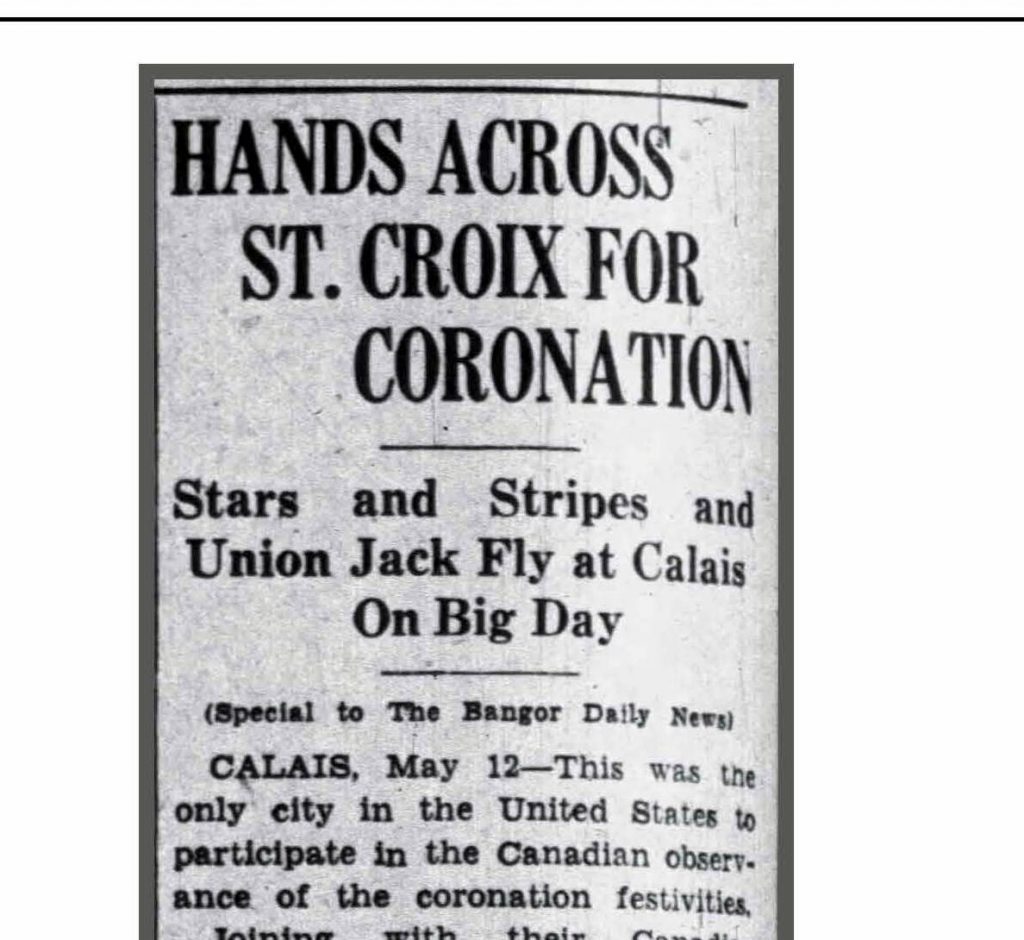
On the Canadian side, 1937 saw the coronation of George VI and his wife Elizabeth as king and queen of the United Kingdom and the Dominions of the British Commonwealth, and as emperor and Empress of India. The ceremony took place at Westminster Abbey, London, on 12 May 1937 and naturally the coronation was celebrated here in the St. Croix Valley. The unique relationship between our towns on the border was the topic of many newspaper articles in both the U.S. and Canada.
The Bangor Daily described the day as follows:
Bangor Daily News May 13, 1937:·
HANDS ACROSS ST. CROIX FOR CORONATION
Stars and Stripes and Union Jack Fly at Calais On Big Day
Special to The Bangor Daily News CALAIS. May 12
This was the only city in the United States to participate in the Canadian observance of the coronation festivities.
Joining with their Canadian neighbors, Calais citizens displayed the American flag with the Union Jack and members of the city government including Mayor Thomas J. Doyle, and members of the city council, firemen and apparatus from Calais and Milltown stations and the Calais City Band were in the parade which formed on King Street, marched to Milltown. N. B, and the motor divisions and the bands paraded the streets of Calais during the forenoon. Mayor Doyle and Aldermen of Calais, Mayor David Wilson and council of St. Stephen, and the municipal officers of Milltown, N. B., American Consul George Brist, and collector Arthur Goucher of His Majesty’s custom service received the salute at the review of the parade.
Prominent in the parade were World War veterans, members of the St. Stephen’s Cadets, the Milltown Cadets, Legionnaires, firemen Knights of Pythias, Catholic Women’s league, Boy Scouts troops and many floats and decorated cars. Music was by the Calais City Band, the St. George band, and the Girls Band of St. George. Both cities displayed much bunting and many street flags, and the towns were thronged with visitors.
The Montreal Star reported:
Troops From Calais Me To Assist NB Group
ST STEPHEN NB May 11—(UP)
American troops will march in the Coronation celebrations at this border town tomorrow and the Mayor of Calais Me and the American Consul will be in the reviewing stand to receive the salute. Militia units of St Stephen and Milltown,NB will be supplemented by additional units from Calais and Milltown, Me.
At other points along the 8000 mile frontier separating Canada and the United States, Americans will flock across the border to witness the celebrations. It is believed however that only at St Stephen will Americans take an active part in celebrations in honor of King George and Queen Elizabeth.
Many from St. Stephen attended the coronation including Mr. and Mrs. Charles Todd who sailed for England on April 24th and Reverend Edmund Hailstone, rector of Christ Church in St. Stephen who took a 6-week vacation to attend the coronation in person.
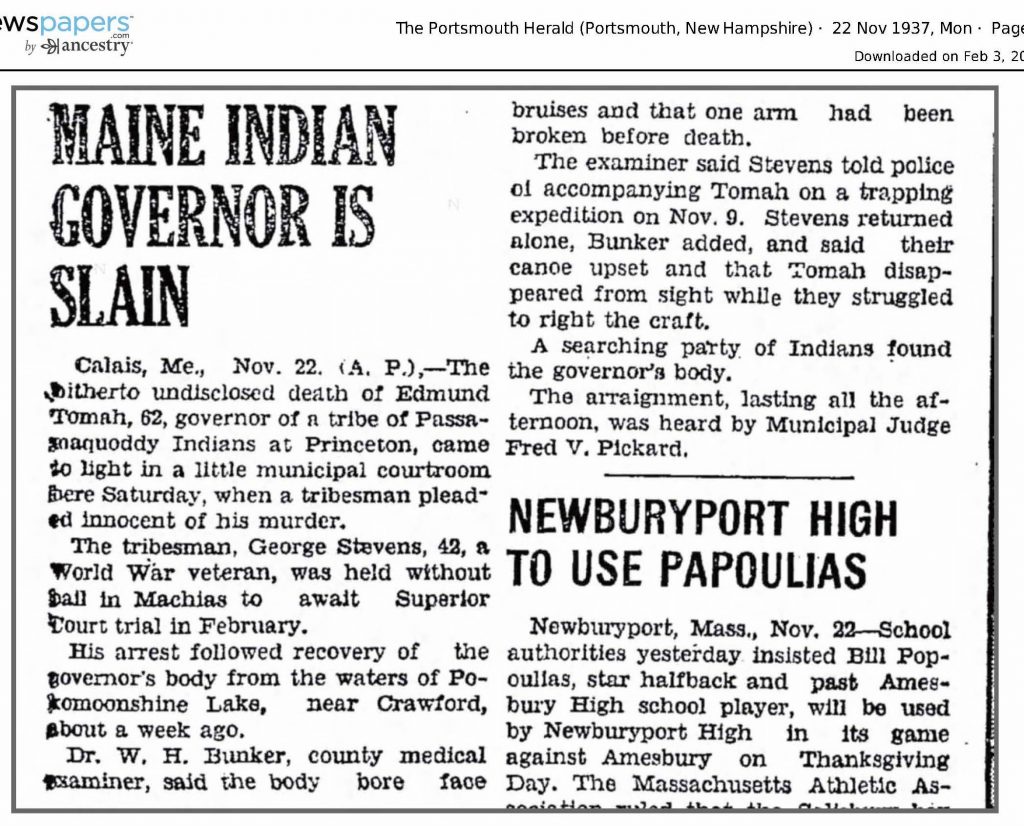
At Peter Dana Point the Tribal Governor, Edmund Tomah, drown in Pocomoonshine Lake under suspicious circumstances and a tribesman George Stevens was charged with his murder. The Governor’s death was reported in newspaper throughout the country.
Calais, Me Nov 22
The hitherto undisclosed death of Edmund Tomah, 62, governor of a tribe of Passamaquoddy Indians at Princeton, came to light in a little municipal courtroom here Saturday, when a tribesman pleaded innocent of his murder. The tribesman, George Stevens, 42, a World War veteran, was held without bail in Machias to await Superior Court trial in February. His arrest followed recovery of the Governor’s body from the waters of Pocomoonshine Lake, near Crawford, about a week ago.
Dr. W, H. Bunker, county medical examiner, said the body bore face bruises and that one arm had been broken before death. The examiner said Stevens told police of accompanying Tomah on a trapping expedition on Nov. 9. Stevens returned alone, Bunker added, and said their canoe upset and that Tomah disappeared from sight while they struggled to right the craft.
A searching party of Indians found the governor’s body. The arraignment, lasting all the afternoon, was heard by Municipal Judge Fred V. Pickard.
The Calais Advertiser reported that Stevens denied the charges, and:
“…according to the story told by Stevens they were crossing the lake after dark on a return trip from Princeton in a canoe when the Governor attempting to stand up, overturned the craft. They were several hundred feet from shore and although the water was less than five feet deep, they lost all their supplies, guns and outfit.
According to the story of Stevens, the Governor could not keep afloat although he had hold of the overturned canoe, and after struggling in the water he disappeared. Stevens made his way to shore in the morning, walked to the highway and was given a ride to the Village. Searchers led by Stevens recovered the body Friday November 12. An examination of the body by Medical Examiner Dr. W. H. Bunker revealed that although Tomah had died from drowning he had suffered a fractured arm, and a bad bruise across his face, before entering the water, the injury apparently inflicted with a smooth weapon.”
The arraignment and trial of Stevens in early March of 1938 is described by the Montreal Gazette:
INDIAN ARRAIGNED FOR MAINE MURDER
Accused Charged by State With Choking Governor of Tribe to Death
Machias, Me., March 1.
The State today opened its attempt to prove that George Stevens, 42-year-old Passamaquoddy Indian, murdered his tribal governor by asserting Edmund Tomah, 62 died of strangulation rather than drowning. County Prosecutor Thomas Bridges told a Superior Court jury there was no water in the governor’s lungs when his body was taken from Crawford Lake last November.
Stevens, who pleaded not guilty, had contended at a lower court arraignment that Tomah drowned November 8 when a canoe carrying the pair on a hunting trip upset accidentally. Before adjournment the jury heard 16 state witnesses, including nine Indians from Peter Dana Point reservation at Princeton, on the Canadian border.
Stevens’ brother, Lawrence, testified Stevens and Tomah were on the friendliest terms when he left them and their supplies at a boat landing on Pocomoonshine Lake, north of Crawford Lake, late in the day before the tragedy. Deputy Sheriff Walter King, Woodland, described the locale where Stevens had reported his chieftain drowned after the two had paddled through a chain of lakes to Crawford Lake. In his outline. Bridges told the jury that Stevens, formerly tribe constable, had been jailed for failure to disclose in a civil action, that Tomah had circulated a petition for Stevens’s removal as constable and that Stevens had threatened to “take care” of the governor. The state would attempt to prove, Bridges said, that Stevens had strangled the governor after their canoe upset, either while the two were wading through the three or four feet of water at the spot or after they reached shore.
The next day the State pathologist, who had already performed one inconclusive autopsy, testified to performing a second autopsy which led him to believe Tomah was strangled. This conclusion was, of course, in direct contradiction to the opinion of Dr. Bunker who himself had performed an autopsy and found “no evidence of strangulation.”
Montreal Gazette March 3, 1938:
FRACTURED LARYNX HELD MURDER CLUE
Injury Described by Doctor During Indian’s Trial for Maine Death
Machias, Me, March 2.
A state pathologist testified late today he found a fractured larynx in the neck of Edmund Tomah, 62-year-old Passamaquoddy Indian governor, whom the State accuses tribesman Charles Stevens of strangling. County Prosecutor Thomas S. Bridges said the organ described by Dr. Arch H. Morrell as causing asphyxia would be shown tomorrow to a Superior Court jury trying the 42-year-old Stevens for murder.
The respondent, who protested innocence, has said the governor was drowned in Crawford Lake last November 8 when a canoe, carrying the two on a hunting trip, upset. Dr. Morrell, on the stand when court adjourned for the night, said that in the second of two autopsies he performed on Tomah’s body he removed all organs of the neck for examination, finding the broken larynx. Dr. William H. Bunker, Calais, medical examiner, had stated that in a previous autopsy he had found no evidence of strangulation.
In broken English four other members of the Passamaquoddy reservation at Peter Dana Point at Princeton, on the Canadian border, had testified there was no enmity between Tomah and Stevens despite the fact the former had circulated a petition for the ouster of Stevens as tribe constable. Defense Counsel contended the petition, allowed temporarily as a state exhibit, was circulated by Tomah because, as governor, it was his duty. The four Indian witnesses were Sammy Tomah, nephew of the governor. Nicholas Lewey and Arthur and Lewey Sophiel.
Given the inconsistency in the medical evidence, the seemingly uncontradicted testimony of tribal members and the Judge’s unusual statement to the jury during his instructions that “the evidence indicated no motive existed for the murder,” which was surely a not-too subtle indication of how the Judge felt about the State’s case, the jury took just three hours to convict Stevens of manslaughter.
Bangor Daily News: March 5, 1938:
Quoddy Indian Found Guilty of Manslaughter
Sent to Prison Ten to Twenty Years After Machias Trial
(Special to the Bangor Daily News
MACHIAS March 4—
The Washington county superior court Jury tonight found George L Stevens 42-year-old Passamaquoddy Indian guilty of manslaughter in the death of his tribal governor Edmund Tomah November 8th.
Stevens who had been tried on a charge of murdering the 62-year-old Indian was immediately sentenced to 10 to 20 years in state prison at Thomaston by Justice George H Worster who in an hour and a half charge to the Jury said the evidence indicated no motive existed for murder. The Jury was out three hours.
Final arguments by state and defense consumed the greater portion of this afternoon’s session of the four-day trial. The World war veteran had contended near the conclusion of his trial that the aged governor drowned accidentally in Crawford Lake when their canoe tipped over. The state pointing to a state pathologist’s report that Tomah died of asphyxia caused by a broken larynx and charged Stevens strangled his chief because he had tried to have him ousted as tribe constable. Police transferred Stevens father of eight children to the county jail.
In other 1937 news from up Township way, 20-year-old Robert Wheaton of Princeton spent 2 and a half days lost in the woods after being separated from his hunting party. 20 volunteers and a plane failed to find him, but he eventually found his way back to the hunting camp from which the hunting party had left.
The legendary Baileyville basketball referee Tony Tammaro turned 20 in 1937 and had interest other than hoops. Tony wanted to be a prize fighter. On July 5th, 1937, Tony who is described in the Bangor Daily as a” classy Woodland lightweight” fought the “hard hammering Rockland warrior, Walter Reynolds.” Tony lost the fight. We don’t know if he continued to box but it wasn’t long before he got to indulge his martial instincts in the employ of Uncle Sam along with his three brothers Vince, Bert and Felix.
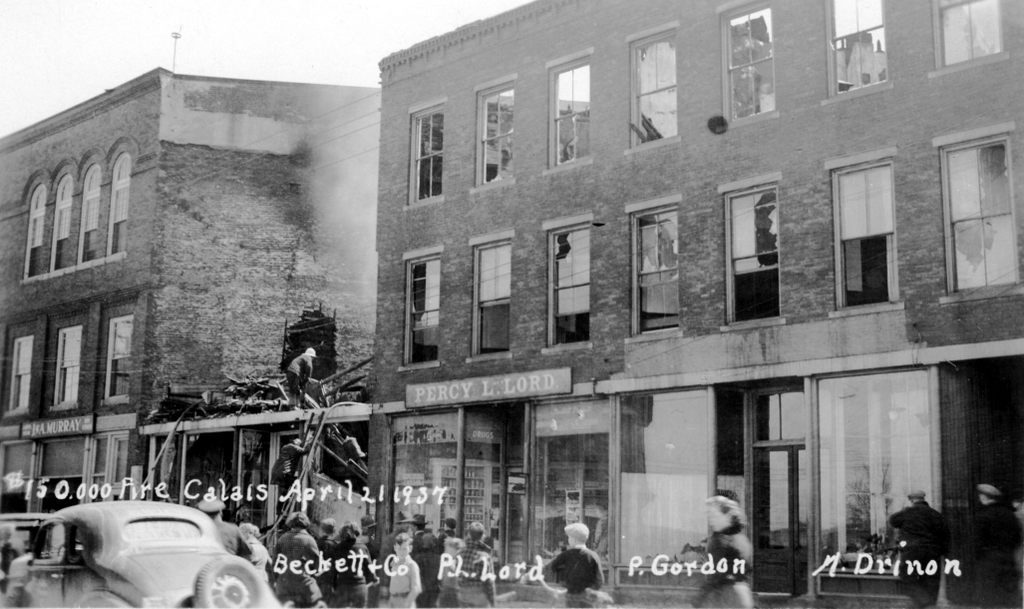
Beckett and Company on Main Street was a total loss after this 1937 fire. In addition, Drinon Clothing, Gordon’s Shoe Store, Lord’s Drug Store and the Calais Advertiser office, which was then on North Street but connected to the Beckett store, were heavily damaged. One important historical loss was the crates of Civil War muskets stored on the third floor. These were all that remained of the hundreds of muskets J. G. Beckett, the family patriarch, had purchased during the Fenian scare of 1866 for sale to the farmers in New Brunswick. The “invasion” of New Brunswick by the Fenians fizzled before J. G. could unload all the muskets which, it was discovered by the initial purchasers, were in any case largely defective. This may have explained why J. G. was able to purchase them for almost nothing.
There was also a homicide in Calais in 1937. Charles McLellan of Woodland was charged with murder in the death of Franklin Mitchell of Calais. The Advertiser reported on December 8, 1937 that:
Mitchell died in the Calais Hospital at 8 o’clock Saturday morning from loss of blood as a result of cuts received when he was allegedly knocked through a plate glass window of the Eastern Café on North Street at about 2:30 Saturday morning following an altercation between the two.
Walter Hiltz, night manager at the Café said the men, who had been drinking heavily, had been arguing and he had separated them, escorting McLellan to the kitchen while others put Mitchell outside. When he was released McLellan followed Mitchell outside and, again from the Advertiser, “hit Mitchell knocking him through the plate glass window. Mitchell staggered to the Liquor Store 15 feet below on North Street, bleeding at every step, where he collapsed.” As the police department had no police car, they called the fire department which arrived only after some delay and transported Mitchell to the hospital where he died of loss of blood. In an amazing display of chutzpah McLellan was arrested at the hospital at 4:30 Saturday morning when he too appeared at the hospital, about the same time Mitchell was being pronounced dead, to be treated for what the Advertiser described as “minor cuts.” McLellan was charged with manslaughter, but the DA eventually dismissed the case.
The Calais International Bank and Trust went belly up in 1937 one of thousands of banks across the country to fold during the Depression. On February 26th 1937 the bank’s assets including the “bank building, the vault in Calais, furniture and fixtures therein, including vault fixtures” and several lots of land and mortgages were auctioned to the highest bidder. The Calais National Bank, Calais’ largest bank, was soon to follow suit and its assets, including the bank building at the corner of Main and North streets, were eventually purchased by the Merrill Bank.
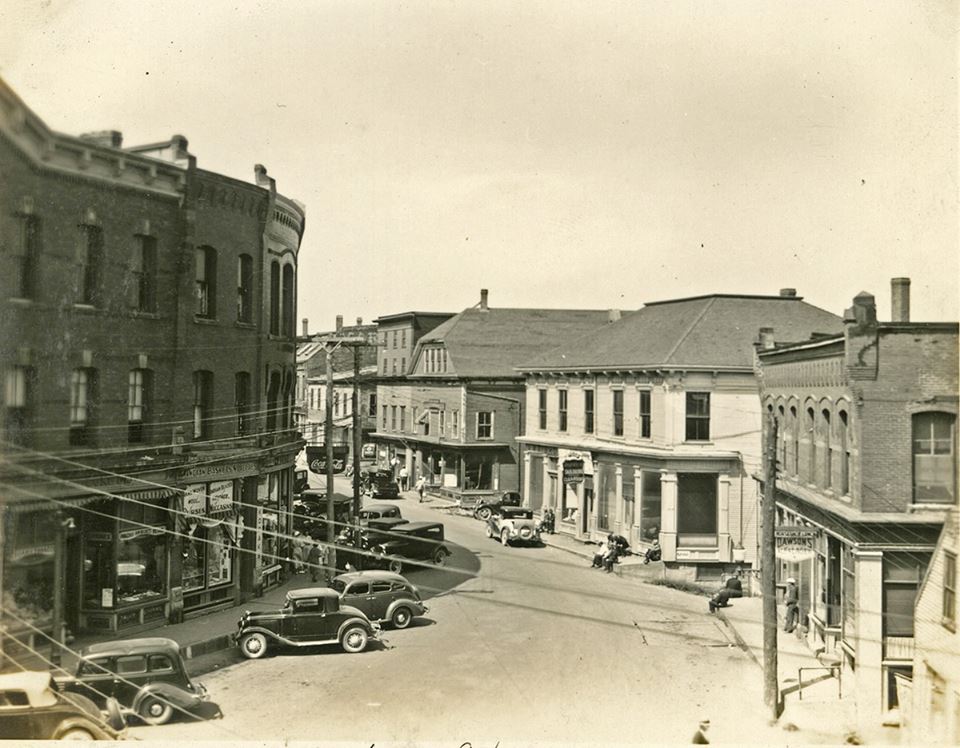
If things were bad in Calais in 1937, they were much worse in Eastport – the City went bust. The bankruptcy was reported in all the national papers because its immediate cause was the failure of the controversial Quoddy project which many in the country thought a wasteful boondoggle.
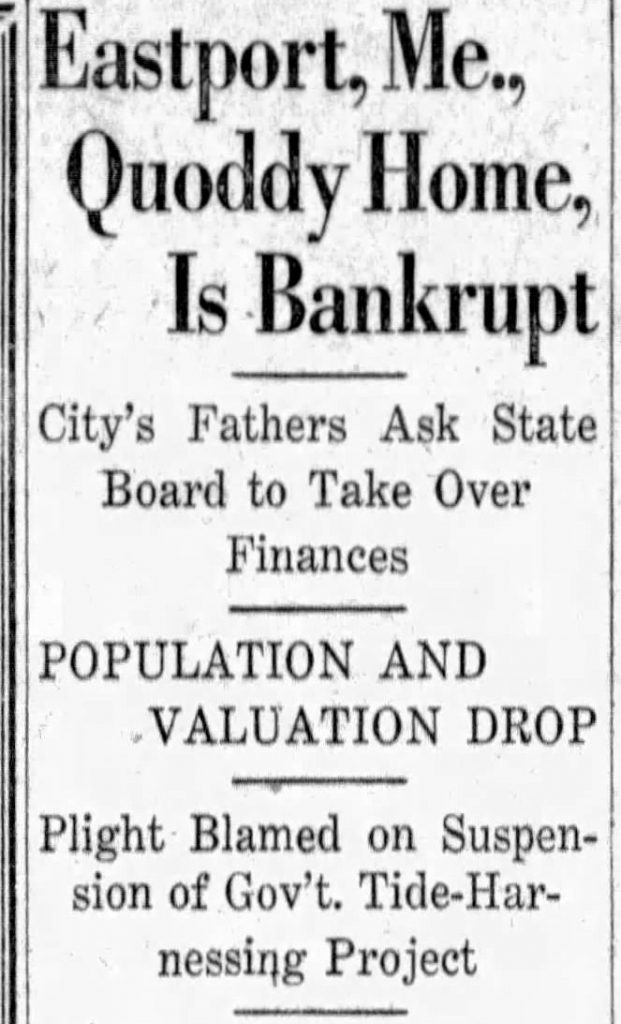
From the Barre Vermont Times December 21, 1937:
Eastport Me
Quoddy Home Is Bankrupt
City’s Fathers Ask State Board to Take Over Finances
POPULATION AND VALUATION DROP Plight Blamed on Suspension of Gov’t Tide-Harnessing Project
Eastport Me Dec 21 (AP)
Eastport, home of the now idle $30,000,000 Passamaquoddy Bay tide-harnessing project, threw in a financial sponge today. It asked the state emergency municipal finance board to take over the city’s finances. Quoddy’s suspension said City Council President Roscoe C Emery was the chief reason for the council’s decision last night “Had Quoddy gone through” he said “we could have pulled through.” Emery said the city had a debt of $170,000, uncollected taxes of $104,000, a population that had dropped from nearly 7000 to 4000 in two years and a valuation of $1,300,000 compared to a peak estimated at well above $2,000,000.
William H Deering, state budget officer and a member of the finance board said it would “in all probability” appoint an administrator. The Quoddy project started In 1933, was halted a year afterward for lack of funds. The government spent $7,000,000 here. More than $1,000,000 went into construction of Quoddy village to house the administrative staff. Later it was used for a time as a scene of an NYA vocational aptitude school, a project to be resumed next month.
Three days later, as reported in the Bangor Daily News
“Miss Doris Wright, veteran city employee, took over temporary administration of Eastport’s tangled financial affairs for the State today pending the appointment of a permanent commissioner.”
The national papers of 1937 found other reasons to keep Eastport in the news. One item which appeared often and seemingly confounded the nation was the Eastport telephone directory which, although a city of 4000 souls, contained “Neither a Smith nor Jones” in the listings. Other important news shared around the country was the fishing acumen of George Gibson who:
“caught 200 pollock off a wharf in seven hours night with his 5-cent line. He baits the hook with a tiny piece of newspaper, cigarette paper or gum wrappers, and the fish attracted by the glow of a nearby streetlight, bit greedily.”
It was certainly safer fishing from the Eastport wharf as the Denton Texas Record Chronicle and many other papers reported in April of 1937, with a touch of sarcasm, that:
“A sea monster has been chasing herring fishermen at Eastport, Maine, they say. It wouldn’t be the Quoddy Project, as this one moves.”
To wrap up Eastport news in 1937 the Miami Herald and other papers reported that “The longest possible telephone call in the United States is from Eastport, Maine to Bay, California, a distance of 2,947 airline miles.” Hopefully folks didn’t waste a lot of money calling City Hall.
Vermont papers reported that Dennysville had shipped Vermont twenty-five hundred snowshoe rabbits in February and March of 1937. The rabbits were to be released throughout the state. Pembroke had its moment of national fame in 1937 when national papers reported that:
“Leland Brown, a Pembroke High School senior, cast as a mummy afflicted with the mumps in the play “The Mummy and the Mumps”, was ill during rehearsals. He had the mumps. After a few days in bed Leland was back with his schoolmates for the presentation of the three-act comedy-his bandage-swathed face swollen for a realistic performance.”
Finally two 1937 items about schools and the Ferry Point Bridge:
The new grade school on Academy Street was built in 1937 to replace the Grammar School which had burned in 1935. The building is now the High Point Apartments. The Baring School burned to ground with nothing saved but the bell, which fell free of the burning building when the tower collapsed.
According to newspaper reports, 7 million people crossed the Ferry Point Bridge in 1937 and one died when he grabbed a live electric cable on the top of the bridge as he was preparing to dive into the river. The deceased was a vaudeville performer in town to play the State Theatre and had joined a group of local boys who regularly dove from the top of the bridge into the river. They had failed to warn him about the electric wires.
